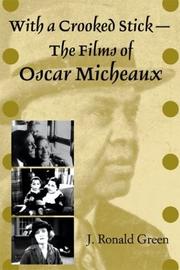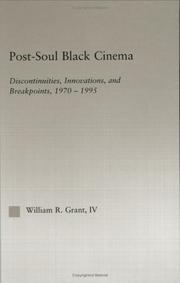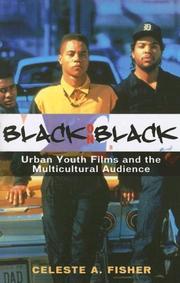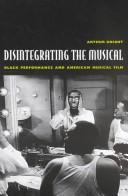| Listing 1 - 10 of 54 | << page >> |
Sort by
|

ISBN: 0253343828 9780253027702 0253027705 9780253343826 0253217156 9780253217158 Year: 2004 Publisher: Bloomington Indiana University Press
Abstract | Keywords | Export | Availability | Bookmark
 Loading...
Loading...Choose an application
- Reference Manager
- EndNote
- RefWorks (Direct export to RefWorks)
Race films. --- Race films --- Race movies --- Motion pictures --- African Americans in motion pictures --- African Americans in the motion picture industry --- Micheaux, Oscar, --- Pioneer, --- Criticism and interpretation.

ISBN: 1135937044 1280171200 0203641914 9780203641910 0415947685 9781135937041 9781280171208 9781135936990 9781135937034 9780415947688 9780415651011 1135937036 Year: 2004 Publisher: New York : Routledge,
Abstract | Keywords | Export | Availability | Bookmark
 Loading...
Loading...Choose an application
- Reference Manager
- EndNote
- RefWorks (Direct export to RefWorks)
This work examines and analyzes how the cinematic image of African Americans became a fixed image with strict rules of depiction both written and unwritten. And, how those very limited and under-informed images would not and could not be challenged or transformed until the power relations in the American film industry began to change and afforded blacks the opportunity at the very least to tell stories from an informed position.

ISBN: 1299396496 1461656885 9781461656883 0810857227 9780810857223 9781299396494 Year: 2006 Publisher: Lanham, Md. Scarecrow Press
Abstract | Keywords | Export | Availability | Bookmark
 Loading...
Loading...Choose an application
- Reference Manager
- EndNote
- RefWorks (Direct export to RefWorks)
Images of violent black masculinity are not new in American culture, but in the late 1980s and early '90s, the social and economic climate in the country contributed to an unprecedented number of films about ghetto life. And while Hollywood reaped financial gains from these depictions, the rest of the country saw an ever widening 'opportunity gap' between marginalized groups and mainstream society, as well as an increase in juvenile violence. These events added to the existing discomfort of the viewing public with representations of young black males living in urban ghettos.
Book
ISBN: 0253050979 Year: 1978 Publisher: Indiana University Press
Abstract | Keywords | Export | Availability | Bookmark
 Loading...
Loading...Choose an application
- Reference Manager
- EndNote
- RefWorks (Direct export to RefWorks)
Cripps delineates the elements of black film genre in a brilliant essay, and then analyzes six films and their position in the genre. The Scar of Shame, a silent classic, is a social drama which expresses black economic aspiration. The St. Louis Blues uses the black musical idiom to express dramatic conflict, and features Bessie Smith's only film appearance. The Blood of Jesus speaks with primitive conviction to a black religious fundamentalism. The U.S. Army film, The Negro Soldier, is a strong advocate for black social goals, despite the constraints imposed by its sponsor. The critically acclaimed Nothing but a Man celebrates a heroic pastoralism through a visually symbolic narrative. The author's final example is Sweet Sweet - back's Baadasssss Song, the most notorious of the recent "blaxploitation" films. The book concludes with a useful survey of black film criticism and features a bibliography, a filmography, and illustrations from the films.

ISBN: 0822329352 0822329638 9786612920370 1282920375 0822384108 Year: 2002 Publisher: Durham, N.C. : Duke University Press,
Abstract | Keywords | Export | Availability | Bookmark
 Loading...
Loading...Choose an application
- Reference Manager
- EndNote
- RefWorks (Direct export to RefWorks)
Publisher's description: From the earliest sound films to the present, American cinema has represented African Americans as decidedly musical. Disintegrating the Musical tracks and analyzes this history of musical representations of African Americans, from blacks and whites in blackface to black-cast musicals to jazz shorts, from sorrow songs to show tunes to bebop and beyond. Arthur Knight focuses on American film's classic sound era, when Hollywood studios made eight all-black-cast musicals₇a focus on Afro-America unparalleled in any other genre. It was during this same period that the first black film stars₇Paul Robeson, Louis Armstrong, Lena Horne, Harry Belafonte, Dorothy Dandridge₇emerged, not coincidentally, from the ranks of musical performers. That these films made so much of the connection between African Americans and musicality was somewhat ironic, Knight points out, because they did so in a form (song) and a genre (the musical) celebrating American social integration, community, and the marriage of opposites₇even as the films themselves were segregated and played before even more strictly segregated audiences. Disintegrating the Musical covers territory both familiar₇Show Boat, Stormy Weather, Porgy and Bess₇and obscure₇musical films by pioneer black director Oscar Micheaux, Lena Horne's first film The Duke Is Tops, specialty numbers tucked into better-known features, and lost classics like the short Jammin' the Blues. It considers the social and cultural contexts from which these films arose and how African American critics and audiences responded to them. Finally, Disintegrating the Musical shows how this history connects with the present practices of contemporary musical films like O Brother, Where Art Thou? and Bamboozled. A lively examination of an important, overlooked element of American cinematic history, Disintegrating the Musical will appeal to those interested in cinema studies and African American studies.
African Americans in motion pictures. --- Musical films --- History and criticism. --- Afro-Americans in motion pictures --- Negroes in moving-pictures --- Motion pictures --- Race films
Book
ISBN: 025301056X 0253010721 9780253010728 1299999824 9781299999824 9780253010643 9780253010568 0253010640 Year: 2014 Publisher: Bloomington : Indiana University Press,
Abstract | Keywords | Export | Availability | Bookmark
 Loading...
Loading...Choose an application
- Reference Manager
- EndNote
- RefWorks (Direct export to RefWorks)
In the early 1900's, so-called race filmmakers set out to produce black-oriented pictures to counteract the racist caricatures that had dominated cinema from its inception. Richard E. Norman, a southern-born white filmmaker, was one such pioneer. From humble beginnings as a roving ""home talent"" filmmaker, recreating photo plays that starred local citizens, Norman would go on to produce high-quality feature-length race pictures. Together with his better-known contemporaries Oscar Micheaux and Noble and George Johnson, Richard E. Norman helped to define early race film making. Making use of
African Americans in motion pictures. --- Race films. --- Afro-Americans in motion pictures --- Negroes in moving-pictures --- Motion pictures --- Race films --- Race movies --- African Americans in motion pictures --- African Americans in the motion picture industry --- Norman, Richard E., --- Norman, R. E. --- Criticism and interpretation.

ISBN: 0814339905 9780814339909 0814330991 9780814330999 Year: 2008 Publisher: Detroit Wayne State University Press
Abstract | Keywords | Export | Availability | Bookmark
 Loading...
Loading...Choose an application
- Reference Manager
- EndNote
- RefWorks (Direct export to RefWorks)
Book
ISBN: 0253018501 9780253018502 0253018447 9780253018441 9780253018441 9780253018373 0253018374 Year: 2015 Publisher: Bloomington
Abstract | Keywords | Export | Availability | Bookmark
 Loading...
Loading...Choose an application
- Reference Manager
- EndNote
- RefWorks (Direct export to RefWorks)
Young, the film's producer and cinematographer, and Khalil Gibran Muhammad, the Director of the Schomburg Center for Research in Black Culture.
Book
ISBN: 025303180X 9780253031808 9780253031754 9780253031792 Year: 2018 Publisher: Bloomington, Indiana
Abstract | Keywords | Export | Availability | Bookmark
 Loading...
Loading...Choose an application
- Reference Manager
- EndNote
- RefWorks (Direct export to RefWorks)
Ivan Dixon's 1973 film The Spook Who Sat by the Door captures the intensity of social and political upheaval during a volatile period in American history. Based on Sam Greenlee's novel by the same name, the film is a searing portrayal of an American black underclass brought to the brink of revolution. This series of critical essays situates the film in its social, political, and cinematic contexts and presents a wealth of related materials, including an extensive interview with Sam Greenlee, the original United Artists' press kit, numerous stills from the film, and a transcription of the screenplay. This fascinating examination of a revolutionary work foregrounds issues of race, class, and social inequality that continue to incite protests and drive political debate
Book
ISBN: 0674966864 0674735595 9780674735590 9780674368057 0674368053 Year: 2014 Publisher: Cambridge, MA
Abstract | Keywords | Export | Availability | Bookmark
 Loading...
Loading...Choose an application
- Reference Manager
- EndNote
- RefWorks (Direct export to RefWorks)
Viewing turn-of-the-century African American history through the lens of cinema, Envisioning Freedom examines the forgotten history of early black film exhibition during the era of mass migration and Jim Crow. By embracing the new medium of moving pictures at the turn of the twentieth century, black Americans forged a collective-if fraught-culture of freedom. In Cara Caddoo's perspective-changing study, African Americans emerge as pioneers of cinema from the 1890s to the 1920s. Across the South and Midwest, moving pictures presented in churches, lodges, and schools raised money and created shared social experiences for black urban communities. As migrants moved northward, bound for Chicago and New York, cinema moved with them. Along these routes, ministers and reformers, preaching messages of racial uplift, used moving pictures as an enticement to attract followers. But as it gained popularity, black cinema also became controversial. Facing a losing competition with movie houses, once-supportive ministers denounced the evils of the "colored theater." Onscreen images sparked arguments over black identity and the meaning of freedom. In 1910, when boxing champion Jack Johnson became the world's first black movie star, representation in film vaulted to the center of black concerns about racial progress. Black leaders demanded self-representation and an end to cinematic mischaracterizations which, they charged, violated the civil rights of African Americans. In 1915, these ideas both led to the creation of an industry that produced "race films" by and for black audiences and sparked the first mass black protest movement of the twentieth century.
Race films. --- African Americans in motion pictures. --- African Americans in the motion picture industry. --- African Americans --- Motion pictures --- Motion picture audiences --- Film audiences --- Filmgoers --- Moviegoers --- Moving-picture audiences --- Performing arts --- Cinema --- Feature films --- Films --- Movies --- Moving-pictures --- Audio-visual materials --- Mass media --- Afro-Americans in the motion picture industry --- Negroes in the moving-picture industry --- Motion picture industry --- Race films --- Afro-Americans in motion pictures --- Negroes in moving-pictures --- Race movies --- African Americans in motion pictures --- African Americans in the motion picture industry --- Social life and customs. --- Distribution --- Audiences --- History and criticism
| Listing 1 - 10 of 54 | << page >> |
Sort by
|

 Search
Search Feedback
Feedback About UniCat
About UniCat  Help
Help News
News